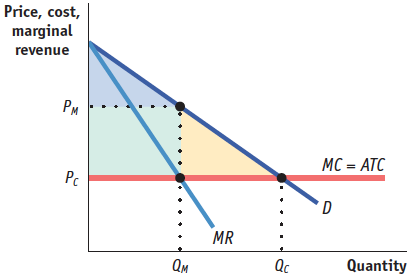Check Your Understanding
Question
What policy should the government adopt in the following cases? Explain.
Internet service in Anytown, OH, is provided by cable. Customers feel they are being overcharged, but the cable company claims it must charge prices that let it recover the costs of laying cable.
Cable Internet service is a natural monopoly, so the government should intervene if it believes that the current price exceeds average total cost, which includes the cost of laying the cable. In this case, it should impose a price ceiling equal to average total cost. If the price does not exceed average total cost, the government should do nothing.The only two airlines that currently fly to Alaska need government approval to merge. Other airlines wish to fly to Alaska but need government-
allocated landing slots to do so. The government should approve the merger only if it fosters competition by transferring some of the company’s landing slots to another, competing airline.
Question
True or false? Explain your answer.
Society’s welfare is lower under monopoly because some consumer surplus is transformed into profit for the monopolist.
False. Although some consumer surplus is indeed transformed into monopoly profit, this is not the source of inefficiency. As can be seen from Figure 62.1, panel (b), the inefficiency arises from the fact that some of the consumer surplus is transformed into deadweight loss (the yellow area), which is a complete loss not captured by consumers, producers, or anyone else.A monopolist causes inefficiency because there are consumers who are willing to pay a price greater than or equal to marginal cost but less than the monopoly price.
True. If a monopolist sold to all customers willing to pay an amount greater than or equal to marginal cost, all mutually beneficial transactions would occur and there would be no deadweight loss.
Question
Suppose a monopolist mistakenly believes that his or her marginal revenue is always equal to the market price. Assuming constant marginal cost and no fixed cost, draw a diagram comparing the level of profit, consumer surplus, total surplus, and deadweight loss for this misguided monopolist compared to a smart monopolist.
As shown in the accompanying diagram, a “smart” profit-maximizing monopolist produces QM , the output level at which MR = MC. A monopolist that mistakenly believes that P = MR produces the output level at which P = MC (when, in fact, P > MR , and at the true profitmaximizing level of output, P > MR = MC ). This misguided monopolist will produce the output level QC , where the demand curve crosses the marginal cost curve&A#8211;the same output level that would be produced if the industry were perfectly competitive. It will charge the price PC , which is equal to marginal cost, and make zero profit. The entire shaded area is equal to consumer surplus, which is also equal to total surplus in this case (since the monopolist receives zero producer surplus). There is no deadweight loss because every consumer who is willing to pay as much as or more than marginal cost gets the good. A smart monopolist, however, will produce the output level QM and charge the price PM . Profit for the smart monopolist is represented by the green area, consumer surplus corresponds to the blue area, and total surplus is equal to the sum of the green and blue areas. The yellow area is the deadweight loss generated by the monopolist.